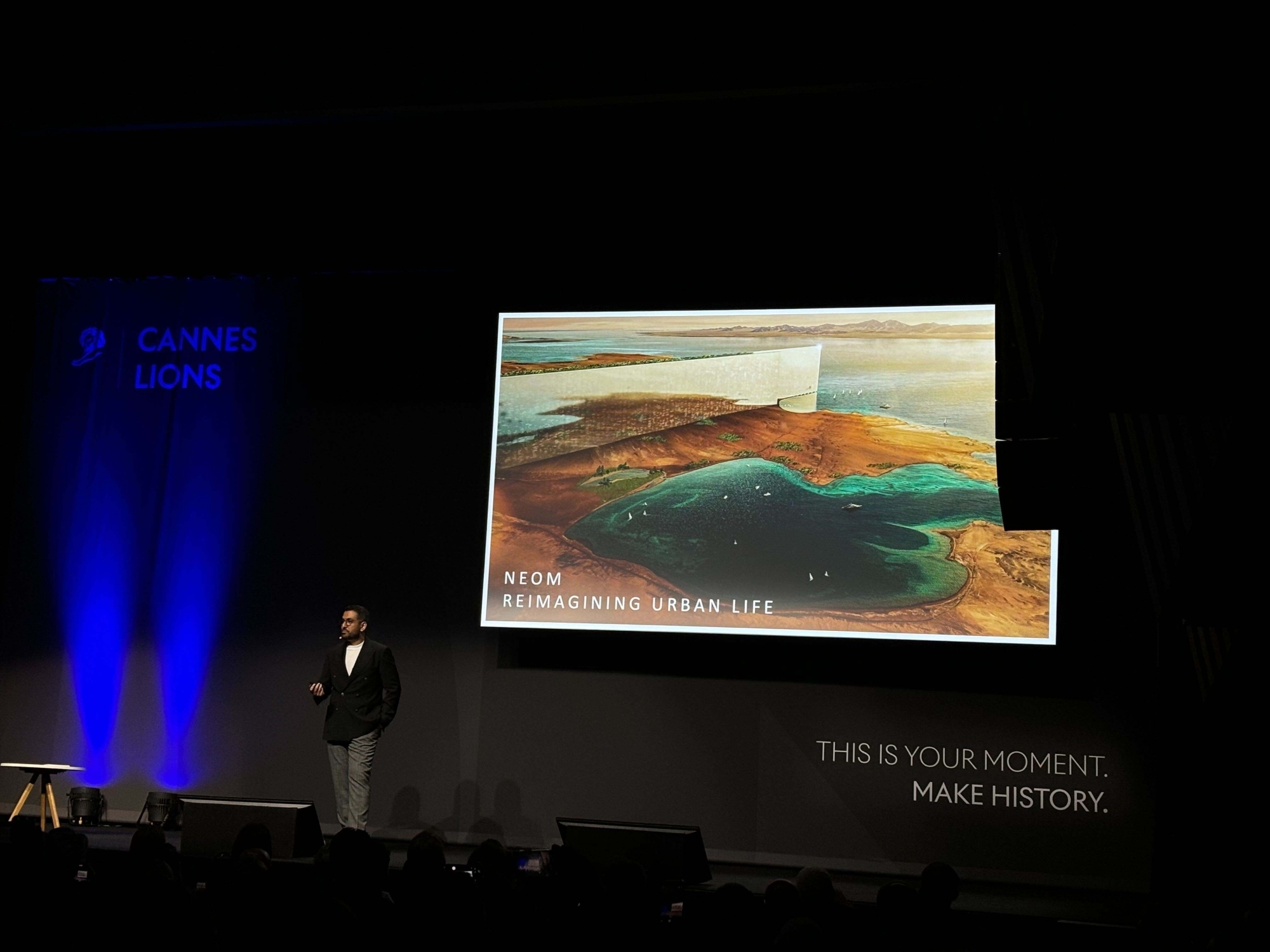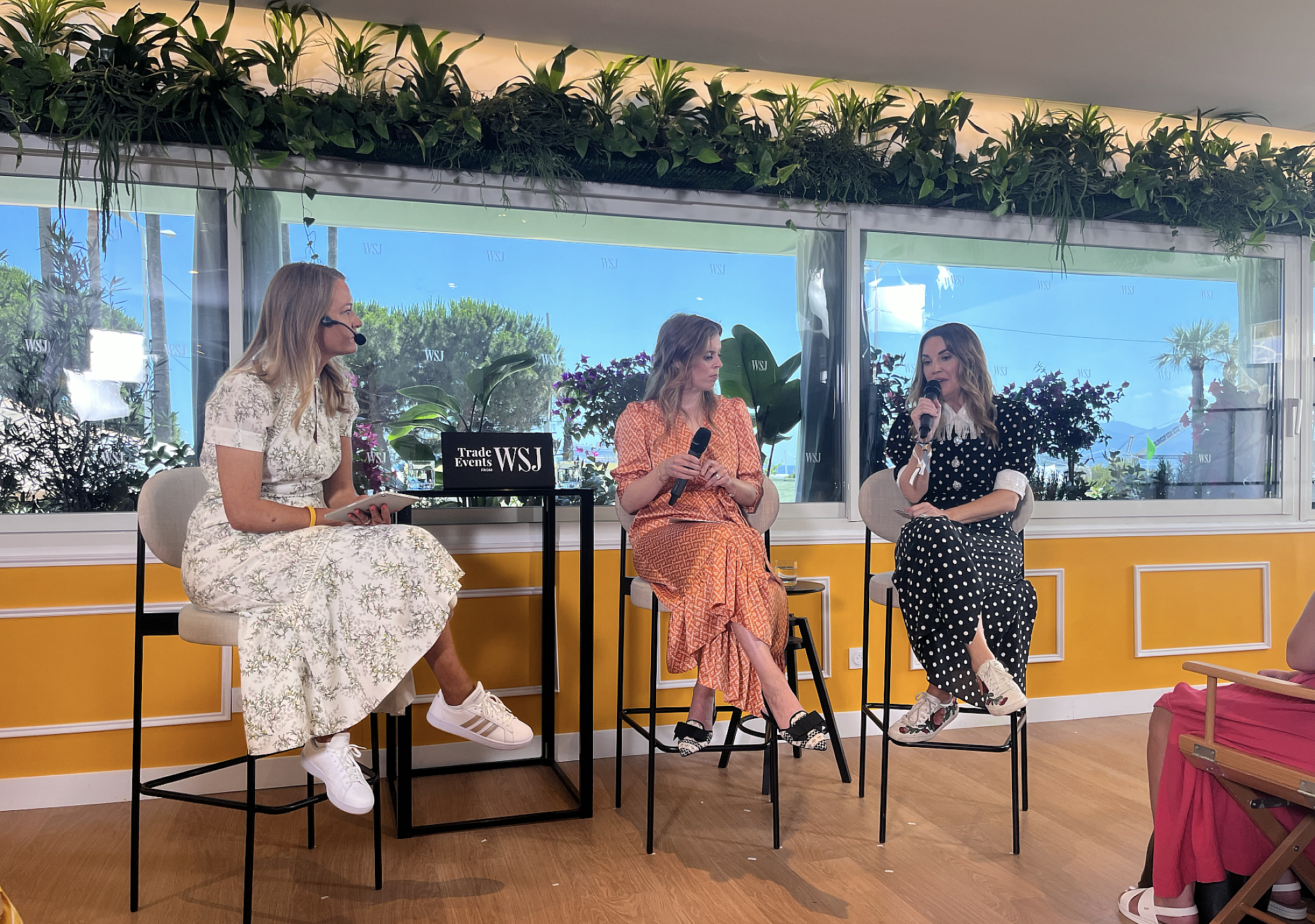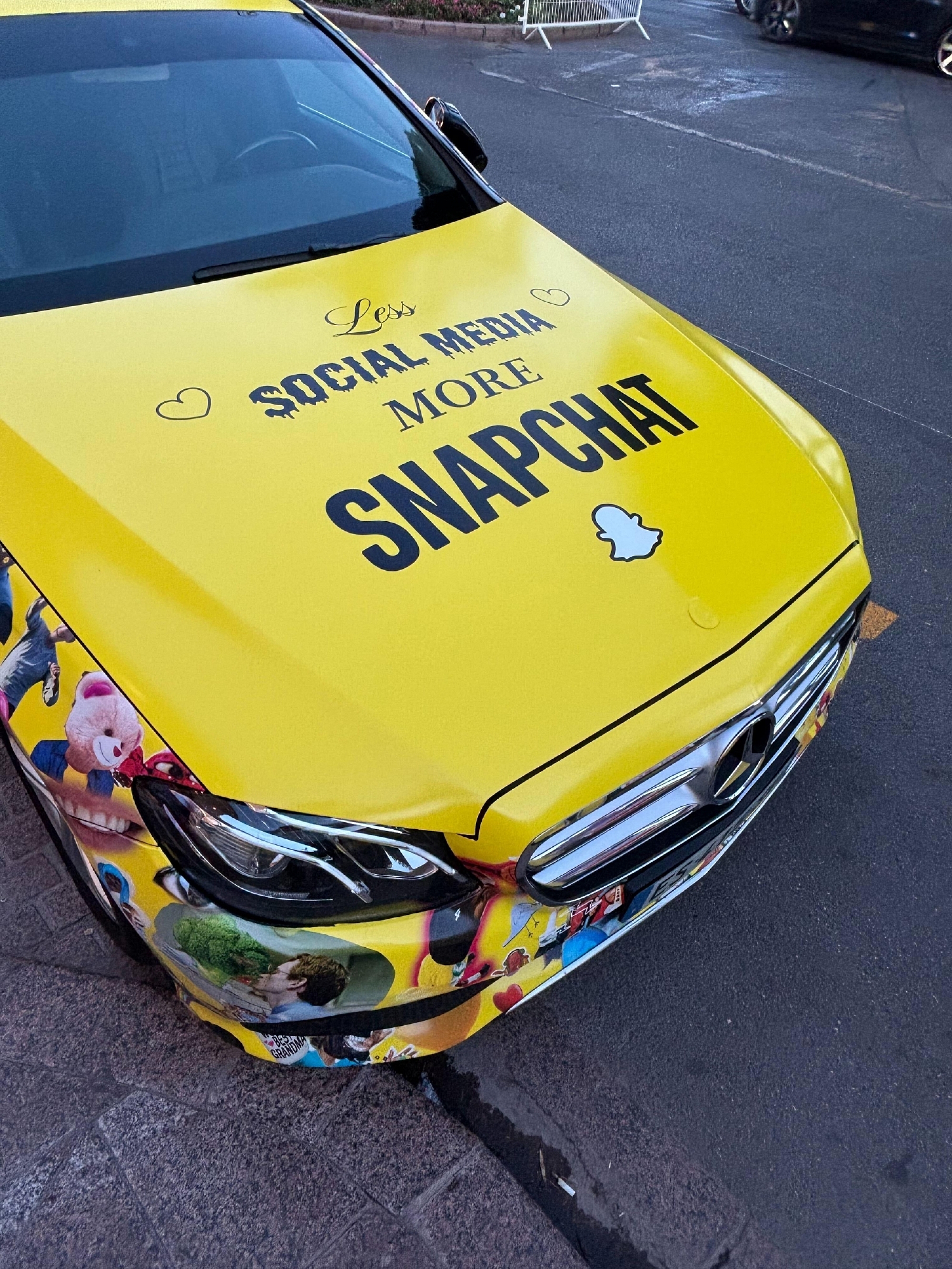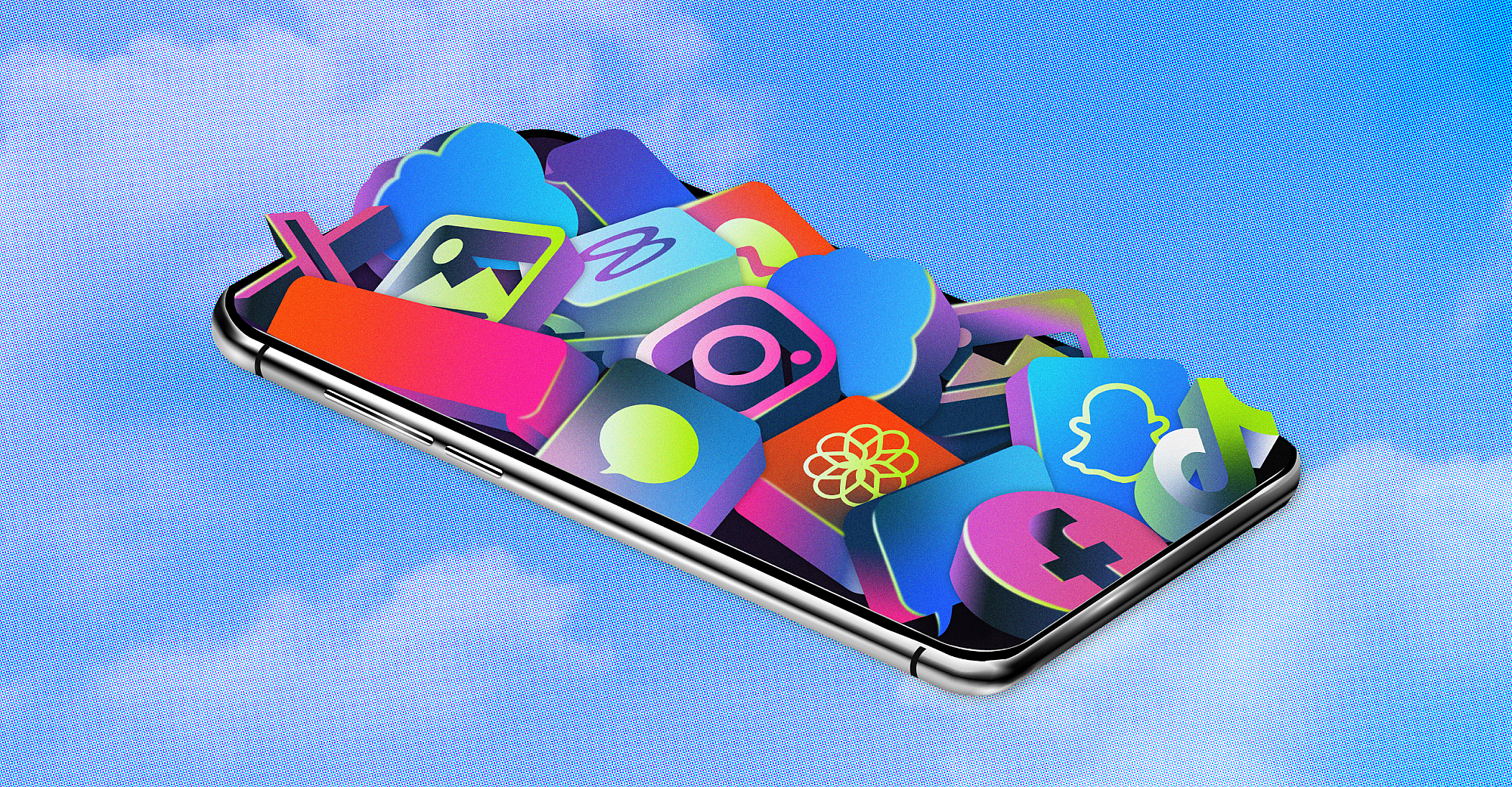
- Text Eli Williams & Clara Malley
- Photography Reid Anderson
Day One is at 2024 Cannes Lions Festival of Creativity, and we’re reporting live from the ground. Tune into Day One FM daily for a special edition of the podcast from Eli and Clara—“Breakfast Epiphanies”—where they break down the highs and lows on the Croisette. Scroll for their Cannes day one recap.
“Come to Saudi!” 🇸🇦
“A new source of creative and economic activity is coming from Saudi,” proclaimed Fahd Hamidaddin, CEO of the Saudi Tourism Authority. Hamidaddin took to the Forum stage at the Palais to talk up the oil-rich nation’s “Vision 2030” plan, the oil-rich Kingdom’s bold and controversial initiative to diversify its economy and shift its spending taps towards tech, tourism, sports, and entertainment.
Cannes isn’t exactly the destination for hard-hitting interviews — the Palais is about as “brand safe” as you’re going to get — so Hamidaddin took to the stage for 30 minutes, standing in front of a glitzy pitch deck that filtered through beautiful (albeit very TBD) architectural renderings of what he called “giga projects.”
This brave new world’s highlights include a soccer stadium built on a 200 foot cliff, Neom, a futuristic mega city embedded between two parallel skyscrapers, and a “regenerative tourism destination” on the Red Sea. The presentation culminated with an ad titled “Go Beyond What You Think,” featuring Lionel Messi, who recently signed on as a pitchman for the Kingdom (allegedly earning him $25 million over three years—everyone has a price). Only the video was cut short, and then it was curtain call. It did feel like an apt metaphor for Vision 2030 overall. Bold promises, failed delivery. Time will tell.
Princess Be-AI-trice
Her Royal Highness Princess Beatrice of York (who is also Afiniti’s VP of partnerships and strategy) joined Spotify’s Dustee Jenkins for a conversation on balancing AI tech with “human-centered” tools. Princess Beatrice stressed the importance of asking clarifying questions in conversations about AI, while Jenkins talked up up Spotify’s “algo-torial” approach: a blend of human curators and tech, which she credited for the success of Daylist, Wrapped, and its new AI DJ which “[expands] your taste with music we think you’ll enjoy."
In the spirit of the above, I have a clarifying question lol. In the context of music curation and other more creative pursuits, is the core issue with AI and algorithms the lack of human touch/emotional intelligence or is it that tech companies are training their algorithms to simulate being almost too human and eager to please? Per discussion about the blanding effects of algorithmic recommendations and the somewhat dystopian use of data collection to reflect your own taste back to you (hello again, Wrapped). Maybe a question for Kyle Chayka after his panel on Wednesday.
Game Time
Stagwell’s Sport Beach returns for its second year, with big-names like Travis and Jason Kelce, Kevin Durant, Sue Bird, and Megan Rapinoe. According to AdAge, the holding company doubled its sponsors to around 40 this year. Axios and Deep Blue are also entering the fray with the Women’s Sport House (pack Dramamine for the shuttle ride).
It makes sense, sports is one of the most influential forces shaping culture today — especially from a media standpoint. It’s the last vestige of appointment viewing, and much like a shift towards individuals and away from institutions happening in news, athletes are becoming huge entertainment entities themselves, building up sprawling media empires that rival traditional outlets.
More to come here, I’m looking forward to hearing Roberto Carlos talk about iconic World Cup moments at the FIFA Plage, which has oddly enough turned into one of the harder venues to get into.
Do You Need Real People to Get Real Insights?
A good man is hard to find—especially if he’s the CFO of an aerospace company and you’re a B2B platform trying to commission a statistically-significant poll on the relevance of sale’s pitch for in-flight GPS technology. Maybe you’ve been there?
Enter Evidenza: an AI consumer research start-up cofounded by LinkedIn alums Jon Lombardo and Peter Weinberg. In a WARC panel at the Palais, they explained that good consumer research can be expensive and tough to actually commission, especially if you’re trying to get in touch with C-suite demographics. Their solve is to tap synthetic people called Impersonas: AI-generated copies of “real” customers with their own “distinct personalities and backgrounds” available to marketers for on-demand interviews. The pitch hinged a lot on the consistency of their AI models with real consumers in head-to-head tests, and the scalability that would allow businesses with a range of budgets and needs to develop campaigns with less guesswork.
If that all sounds vaguely dystopian, heard and concurred. But who knows, my take may be phased out: Lombardo and Weinberg predicted every brand will have a synthetic insights program in five years.
Mind the Gap Between Marketing and Reality
In the latter half of the same WARC panel, R/GA’s Yael Cesarkas promised to give tactical tips for bursting the bubble that disconnects creative strategy—and marketing in general—from real-life people.
She explained the problem is twofold. First, strategy has been reduced to curation; we’re all sifting through the same white papers, surveys and articles. She had an especially bleak slide of run-ragged stats which included “Gen Z likes to stand out in a crowd” and “Gen Z prefers ethical brands.” Each appeared in 70-80% of the 1000s of briefs her team analyzed. Second, a lot of the data we’re finding there is biased, either based on the attitudes of the brands or outlets commissioning the surveys or by the respondents themselves who are being asked to self-report on their beliefs and behaviors.
In her view, strategists should pair self-reported, or attitudinal data (like “I prefer ethical brands”) with behavioral data (like “I also spent $1K at Shein last year) to illuminate “the gap between aspiration and reality” and creatives should then work to solve that tension.
I’ve been hoping a “come to Jesus” was on the way for lazy data (as outlined in this year’s Predictionary) and it’s heartening to see we weren’t the only ones.
Google’s I/Opener
We sweat through a demo of some of Google’s latest AI features. The speakers previewed the power of Gemini’s image generator, showing what looked like a screen saver featuring an array of remixed Google logos, like one made out of croissants (lol, “could a human have done this?!”). There was a more robust Google Trends infrastructure buildout, a campaign testing mechanism, and ChatGPT-adjacent “creative prompts” features. It did seem like a redux of the company’s slightly awkward roll-out of Google I/O and AI Overviews. Perhaps a coincidence? Anthony Fantano lookalike Marc Rebillet, who DJ’d the keynote “pre-show,” was also headlining the happy hour (we left before that kicked off).
It was the first real AI “talk” that I went to, so more to come, but the whole thing was a bit awkward. It might’ve been the constant, slightly disingenuous reassurances sprinkled throughout, like the flight attendant saying “don’t worry about that missing bolt.” I think I’m good. AI is still in its nascent stage, and will likely render lot of creative work obsolete, but I’m still bullish on people. Like Clara said on the pod, I’d rather be in a room with a bunch of other people coming up with shitty thought-starters than having a machine spit one out for me.






